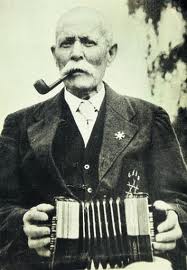Annotation:Headington Morris Reel: Difference between revisions
m (Text replace - "[[{{BASEPAGENAME}}|Tune properties and standard notation]]" to "'''Back to [[{{BASEPAGENAME}}]]'''") |
No edit summary |
||
| Line 1: | Line 1: | ||
'''Back to [[{{BASEPAGENAME}}]]''' | =='''Back to [[{{BASEPAGENAME}}]]'''== | ||
---- | ---- | ||
<p><font face="garamond, serif" size="4"> | <p><font face="garamond, serif" size="4"> | ||
'''HEADINGTON MORRIS REEL'''. English, Morris Dance Tune (4/4 time). G Major. Standard tuning (fiddle). AABB (x4), A. From the village of Headington, in England's Cotswolds. The tune comes from the playing of Anglo-concertina player William Kimber at Headington Quarry, Oxford. Kimber was a member of the Headington Morris | '''HEADINGTON MORRIS REEL'''. English, Morris Dance Tune (4/4 or 2/2 time). G Major. Standard tuning (fiddle). AABB (x4), A. From the village of Headington, in England's Cotswolds. The tune comes from the playing of Anglo-concertina player William Kimber at Headington Quarry, Oxford. Kimber was a member of the Headington Quarry Morris Dancers in December, 1899, when Cecil Sharp came to see them, an event that helped trigger his interest in English folk dance, which in turn led to a revival of traditional tunes and dances. Kimber was still playing when he was recorded in 1946 and 1948 in the studio by Douglas Kennedy, and later (in the 1950's) by Peter Kennedy. | ||
[[File:kimber.jpg|200px|thumb|left|William Kimber]] | |||
<br> | <br> | ||
<br> | <br> | ||
| Line 12: | Line 13: | ||
</font></p> | </font></p> | ||
<p><font face="garamond, serif" size="4"> | <p><font face="garamond, serif" size="4"> | ||
''Printed sources'': Mallinson ('''Mally's Cotswold Morris Book'''), 1988; No. 49, p. 30. | ''Printed sources'': Bacon ('''The Morris Ring'''), 1974; p. 189. Mallinson ('''Mally's Cotswold Morris Book'''), 1988; No. 49, p. 30. | ||
<br> | <br> | ||
<br> | <br> | ||
| Line 22: | Line 23: | ||
<br> | <br> | ||
---- | ---- | ||
'''Back to [[{{BASEPAGENAME}}]]''' | =='''Back to [[{{BASEPAGENAME}}]]'''== | ||
Revision as of 22:52, 20 January 2014
Back to Headington Morris Reel
HEADINGTON MORRIS REEL. English, Morris Dance Tune (4/4 or 2/2 time). G Major. Standard tuning (fiddle). AABB (x4), A. From the village of Headington, in England's Cotswolds. The tune comes from the playing of Anglo-concertina player William Kimber at Headington Quarry, Oxford. Kimber was a member of the Headington Quarry Morris Dancers in December, 1899, when Cecil Sharp came to see them, an event that helped trigger his interest in English folk dance, which in turn led to a revival of traditional tunes and dances. Kimber was still playing when he was recorded in 1946 and 1948 in the studio by Douglas Kennedy, and later (in the 1950's) by Peter Kennedy.

Source for notated version:
Printed sources: Bacon (The Morris Ring), 1974; p. 189. Mallinson (Mally's Cotswold Morris Book), 1988; No. 49, p. 30.
Recorded sources:
